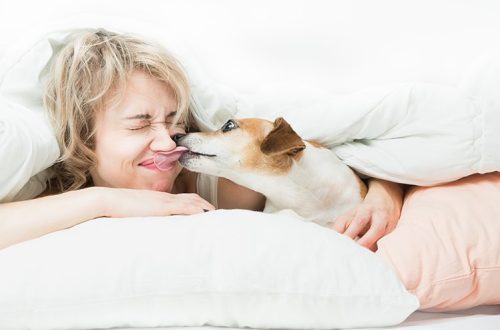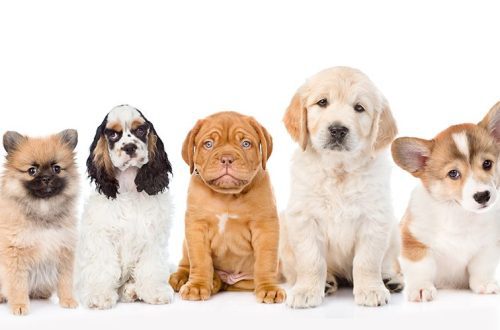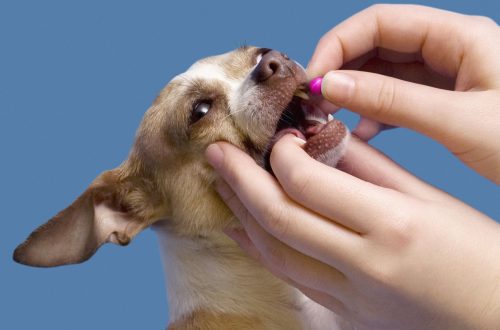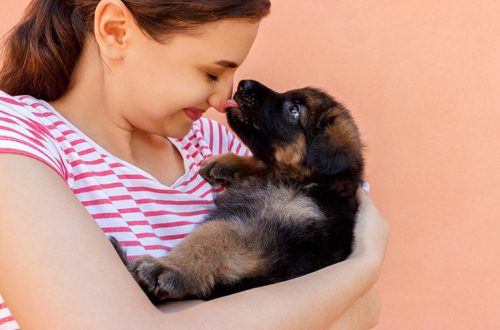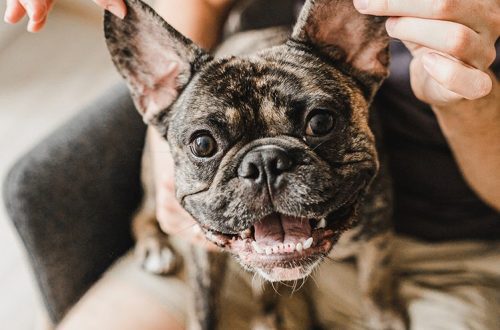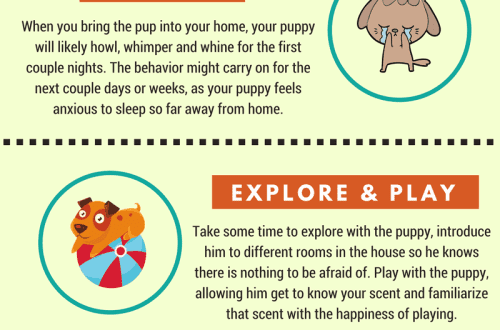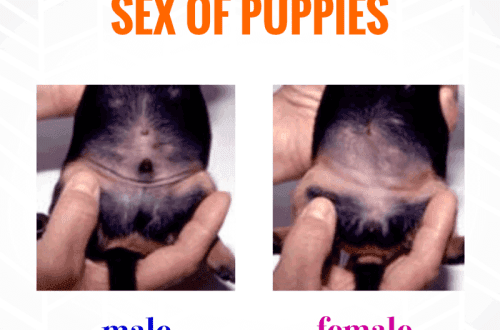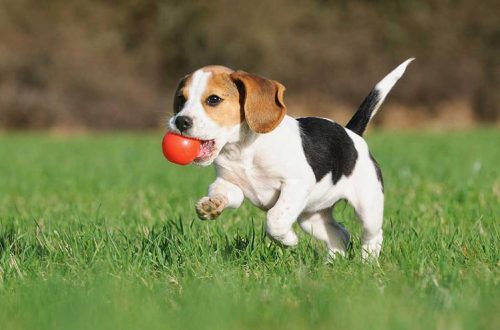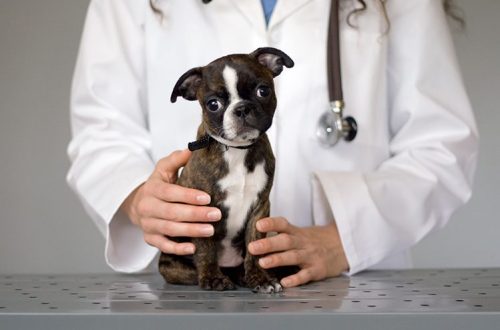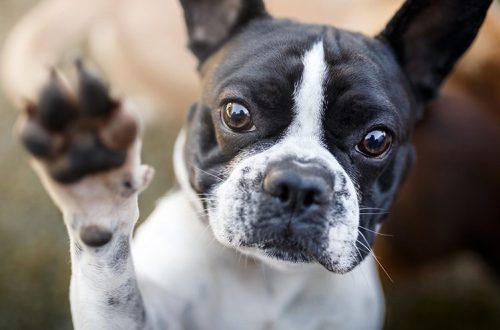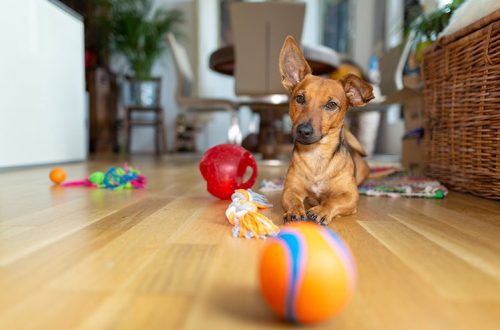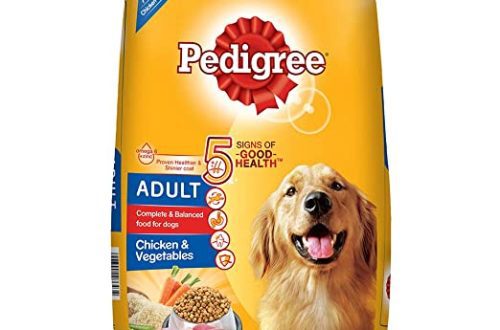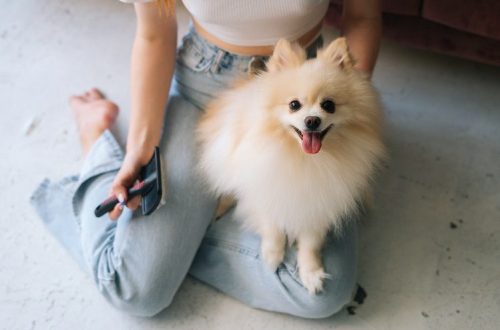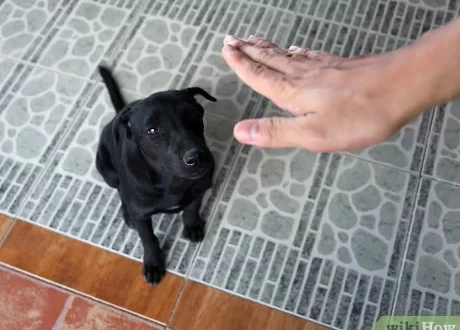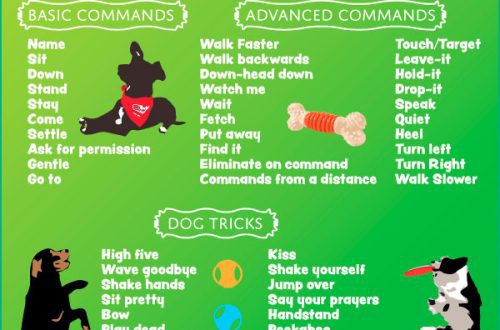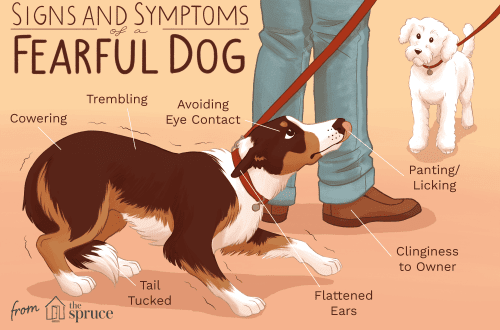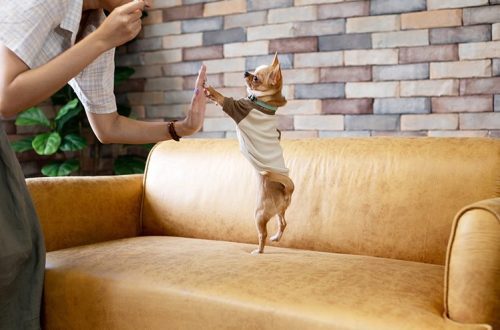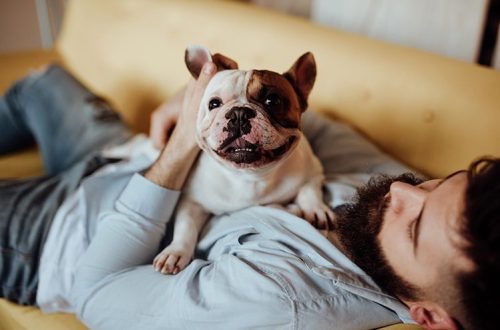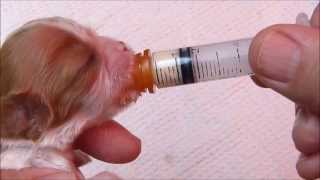
All About the Puppy
Proper nutrition and good care are the foundations of a dog’s health, longevity and happy life. Therefore, even before buying a puppy, you will need to think carefully about all related issues.
Puppies grow very quickly, and for their harmonious development, both physical and mental, the first months of life are very important.
FEATURES OF THE MENTAL AND PHYSICAL DEVELOPMENT OF PUPPIES BY MONTHS

PUPPY AT 1 MONTH OLD
At one month, or four and a half weeks, the puppies are still living with their mother and siblings. Not so long ago they began to hear and see, and during this period they have an active phase of exploring the surrounding space, new sounds, smells, surrounding people and animals. Monthly puppies are still too small to make meaningful actions, as long as they are all based on instincts and communication with their mother. As a rule, breeders do not sell puppies at the age of one month, giving them the opportunity to get stronger, to get the first lessons in socialization. Human interaction during this period is very important for puppies to develop as companion dogs.
From a month to two, puppies have an active phase of memorization or, in other words, an identification phase. The puppy begins to meaningfully recognize parents, form social relationships with littermates and people.
Growling and taking away a toy from a brother or sister, biting your mother on the cheek to share food, running away from a person or running up to him. During this period, each puppy has a lot of similar questions, the answers to which he receives by performing an action and receiving a reaction. The sister gave the toy away, which means it is weaker, next time you can take the toy away again. Mom growled and shook her scruff, so don’t bite her on the cheek. The person came and pleasantly stroked or screamed loudly – depending on the action, the puppy will build its further reactions to repetitive stimuli.
PUPPY AT 2-3 MONTHS OLD
Two- and three-month-old puppies are very affectionate, inquisitive and sociable. They are active and constantly exploring something. For example, when meeting strangers, they run up to them completely fearlessly, sniff, caress, jump, sometimes bark. Therefore, during this period, they can easily develop positive skills associated with any activity. At this time, the puppy can easily be taught to follow the commands “Place!”, “Come!”, “Walk!”.

PUPPY AT 3-4 MONTHS OLD
Skills for the commands “Sit!”, “Lie down!”, “No!” the puppy will work out much easier at the age of 3.5-4 months. This is due to the fact that such commands are based on inhibitory reactions that are not yet developed in the puppy at an earlier age.

PUPPY AT 4-5 MONTHS
At the age of 4-5 months, the puppy needs regular walks, gradually increasing in time and complexity, which are important both for his physical development and for the accumulation of life experience. During this period, the puppy is developing the characteristics of his nervous system, his character can noticeably change. When meeting with strangers, the puppy may no longer run up to them to start a game, but only observe from the side, and at the first manifestation of even unsharply pronounced threatening actions by outsiders, they get scared and run away. Therefore, this time is also called the period of fears.
At this time, the owner is required to be very careful, affectionate handling of the puppy, careful observation of what can scare him. You need to try to predict such a moment in order to distract the puppy from the negative reaction in time with a treat or a game.
List of All Articles About Puppies
AT WHAT AGE IS IT BETTER TO TAKE A PUPPY
As a rule, puppies are given to new families at the age of 1.5-2.5 months, and breeders can keep dogs of small or dwarf breeds up to 3-3.5 months.
If you are offered to take a puppy at the age of 1 month, it is better not to do this, giving the baby the opportunity to grow up in his own family for another month.
No matter at what age you took a puppy, at two months, at three or four, try to establish the right relationship with him from the first day, which is commonly called good contact. This will allow him to develop affection for you, obedience, devotion, and subsequently love. For this you need:
- always take care of your pet
- feed him in time, walk him, comb him – that is, take care of him,
- exercise regularly with him, combining games and initial training.
Try to ensure that any troubles in life do not affect communication with the puppy. Dogs very subtly feel the mood of their owner and react accordingly.
PROBLEMS AS YOUR PUPPY GROWS
Problems that can arise during the growth period of puppies of any breed are mostly associated with improper feeding. The amount of feed should be constantly measured in relatively small portions to avoid overeating. Obesity in dogs puts a lot of stress on the heart and circulation. It happens that even weak ligaments and joints are exposed to unnecessary excessive stress in puppies and young dogs. The consequence of this can be diseases associated with the paws and joints. With proper nutrition, the puppy should actively play, run, and explore the territory several times a day. Too tiring walks for several hours in the first year of life should be avoided. If your dog is unwell, contact the dog breeder or veterinarian immediately.
KEY POINTS IN CARING FOR A PUPPY FROM 2 TO 5 MONTHS
In order to lay a solid foundation for the health of the dog from childhood, it will be necessary to vaccinate and deworm the puppy at strictly defined periods.
DEWORMING AND VACCINATIONS
The first deworming procedures are carried out by the dog breeder. Together with basic housing and feeding instructions, he will tell you about the exact schedule for further deworming and vaccination procedures. Usually the owner of the puppy gives him an anthelmintic drug before the next vaccination, ten days before it.
1 MONTH
As mentioned above, at the age of one month, the puppy is still too small to tear him away from his family. Good breeders do not give away their wards at such a young age, but leave them in the company of their mother, at least for another half a month or a month. During this time, the puppy is actively adapting to the outside world.
If, however, circumstances have developed that you have a one-month-old puppy, then you will need to give him the first vaccination when he is 6 weeks old. If you are unsure about the best time to start vaccinating, contact your breeder or veterinarian.
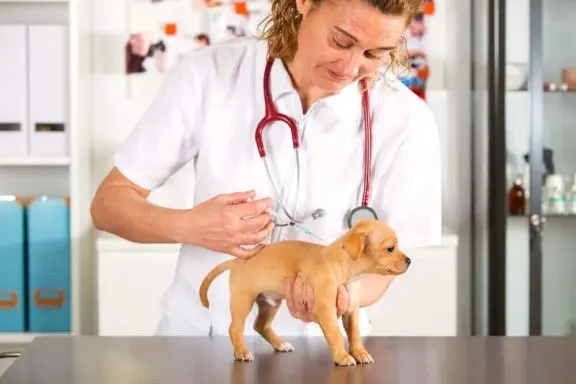
2 MONTHS
If you pick up your puppy from a breeder at the age of 2-2.5 months, then, as a rule, the first vaccination of the puppies is done by the breeder. This happens when the puppies are 8-9 weeks old, so he comes to you already vaccinated. The second vaccination should be done by the owner when the puppy is 12 weeks old. It must be remembered that until the second vaccination is given to the puppy, he must be quarantined. For a detailed explanation of the timing of vaccinations, you can contact the puppy’s breeder.
3 MONTHS
If for some reason it happened that the puppy did not receive his first vaccination either at the age of 6 weeks or at the age of 8-9 weeks, you must use the third option of the vaccination schedule. This means that the puppy should be vaccinated for the first time at 12 weeks of age and revaccinated between 14 and 16 weeks of age. In order not to get confused in the timing and make the necessary vaccinations on time, it is recommended to have a calendar where the puppy’s age in weeks and the necessary weeks for vaccination will be marked. Or you can seek the advice of a veterinarian.
A later vaccination date does not change the fact that it will be necessary to keep the puppy in quarantine until the second vaccination is completed. This means that he will not yet be able to communicate with his relatives on the street.
4 MONTHS
If the puppy has been vaccinated according to the standard vaccination schedule, it means that at 4 months old he is already fully vaccinated, the quarantine has been lifted, and you can enjoy walking together, getting to know other dogs and doing initial training.
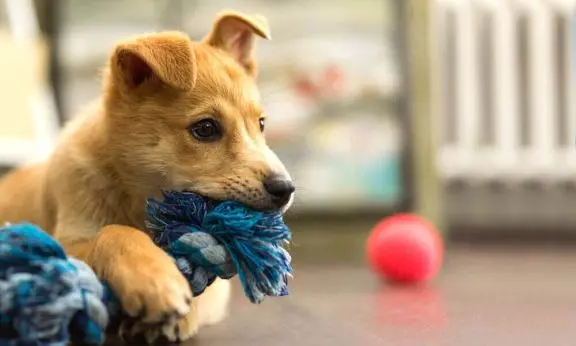
5 MONTHS
At the age of 5 months, the puppy should be active, already fully accustomed to the house, know his nickname, a few basic commands, understand what is possible and what is not.
During this period, he still continues to change his teeth from milk to permanent, which begins at about three months and lasts up to seven months. During this period, you need to monitor the puppy’s oral cavity, monitoring whether milk teeth fall out. This is important both for the health of the dog and for the formation of the correct bite.
PUPPY HEALTH AND APPEARANCE
LEARNING TO WALK
Regardless of the season, it is necessary to accustom the puppy to walks. Immediately after sleep and after each feeding, the puppy must be taken outside for 5-10 minutes to accustom him to the toilet. The more often you take your puppy outside, the faster he will understand what is wanted from him, and the faster he will get used to going to the toilet outside the house.
Longer walks, for the sake of play and active movement, are recommended between feedings. It is worth slightly increasing the time spent outdoors from 15 minutes to two hours a day, depending on the weather and season. Of course, it is important to consider the breed and age of the puppy. At first, a two-three-month-old puppy can be carried outside in your arms. At the same time, if the puppy has not yet completed the entire course of vaccinations, all contact with other dogs should be excluded.
During the walk, the puppy must be in motion, do not let him sit or lie on the cold ground. At two months, it is already possible to teach a puppy to a leash. The puppy gets used to the soft light collar quickly. At first, you need to lead him on a leash so that the puppy feels that you are leading him. Follow him (the leash should be long enough) and carefully, without jerking, take him away from unwanted places. It is necessary to ensure that the puppy does not eat unsuitable food items from the street.
By the third or fourth month during a walk, you can walk up to one and a half kilometers with a puppy of a large breed, with a puppy of a medium or small breed, this distance should be proportionally reduced. Increase the distance gradually, do not tire the puppy with too much exercise, otherwise he will lose his appetite and will not grow well.
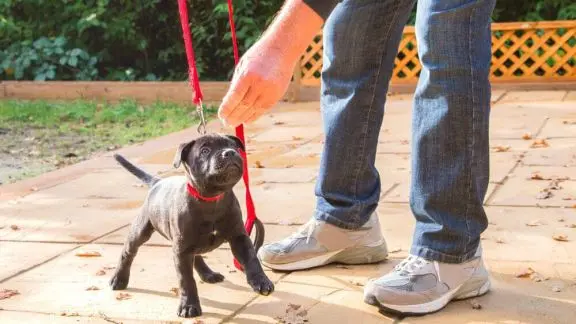
With a five-month-old puppy, you can already run in deep snow, earth, sand, play active outdoor games, swim, let him accompany the owner on a ski or bike ride. But even here you can’t overwork the puppy, at the first sign of fatigue, you need to take a break or stop walking.
When walking with a puppy, teach him not to pay attention to noise, not to be afraid of cars, gradually moving with him from quiet streets to more noisy ones. The puppy needs both free walking and playing with peers. Socialization is especially needed for a puppy living in a private home. Keep him away from stray and unfamiliar dogs, as they can infect him with infectious diseases. During walks, you can teach your puppy to play with balloons: praise him and rejoice with him when the balloon bursts. This game will strengthen the psyche, and the puppy will not be afraid of fireworks and explosions of firecrackers.
If the puppy lives in an apartment, then walks are allowed after the first vaccination. But you need to make sure that he does not meet other dogs on the street until the second vaccination. If the puppy will live in a private house, where he will be alone on his territory, you can start walking from the first day of being at home.
After a walk, especially in wet weather, you need to wipe or wash the puppy’s paws and stomach. In winter, it is simply necessary to do this so that street reagents do not irritate or injure the skin on the paw pads.
DAILY CARE
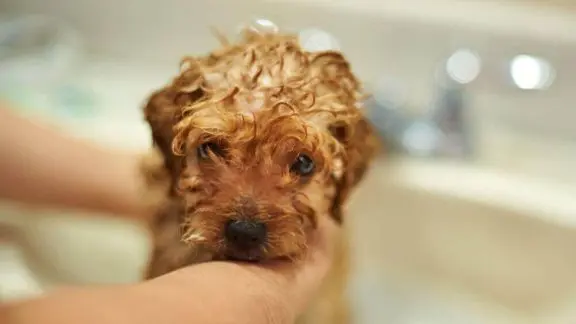
Grooming time is not just a time for caring for a puppy, but also a great opportunity to communicate, make contact, pet a pet.
HAIR CARE
To groom a puppy with a short coat, you need a brush with natural bristles and a comb with fine metal teeth for grooming during shedding. An ideal care product for short-haired dogs is a massage mitt. For puppies of long-haired breeds, a slicker brush is still needed.
Puppies of all breeds will also need nail clippers, towels, shampoos. Bathe your puppy only as needed. Combing the more often, the better – this is how the puppy gets used to being touched, and this will come in handy in the future. Put the puppy down regularly, inspect the tummy, paws. In the future, he will not be afraid of human hands.
If you have a puppy of a breed that is characterized by a very long coat or a coat with a thick undercoat, you can go to a professional groomer to get the puppy used to brushing from childhood.
DENTAL CARE
Clean teeth are the key to good health. On sale now there are a large number of a wide variety of chewing sticks that act as a toothbrush, as well as special toothpastes and brushes for dogs.
During the growth period from 3 to 7 months, puppies change teeth from milk to permanent. At this time, it is important to follow the process of changing, and if necessary, contact the services of a veterinarian.
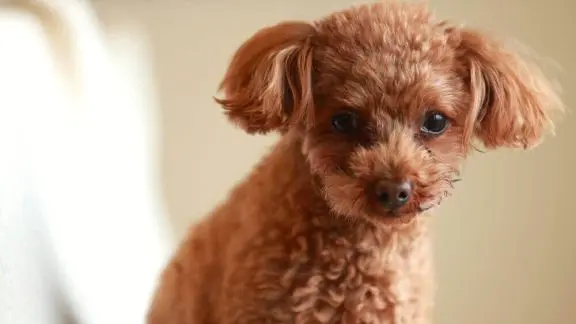
EAR CARE
Bathing a puppy is only necessary if necessary, if, for example, he is dirty in something. After each walk, wash and wipe the paws and stomach. When you wash your pet, be careful not to get water in his ears: moisture in the ear canal can promote fungal and other diseases. If the ears are dirty, take a damp swab and lightly remove the dirt. If the ears are dirty inside, wipe them with a cotton swab moistened with a special lotion, but not deep. Clean ears must be dry. In puppies with hanging ears, the ear canals are closed and not ventilated, therefore, for prevention, we recommend using special ear cleaners once every one to two weeks.
NAIL CARE
Nails are trimmed as needed. If the dog wears off its claws during walks, they are not trimmed. It is advisable to regularly feel the paws and fingers: if someday the dog cuts its paw, you will be able to provide first aid in a timely manner and apply a bandage.
Long claws can cause the paws to turn out even when set correctly. When shearing, the claws are shortened, and the paw becomes in place, so it is very important to ensure that the claws do not grow unnecessarily. Start clipping or sharpening your puppy’s nails as early as possible, every one to two weeks. For small puppies, clippers from a manicure set are well suited. When conventional clippers are no longer suitable, you will need to use special clippers for dog claws. There are blood vessels in every claw, and if you hit them, they will bleed, so try to avoid this when trimming your nails. If trouble happens, treat with hydrogen peroxide or use a special hemostatic pencil that can be bought at a pharmacy.
PUPPY NUTRITION
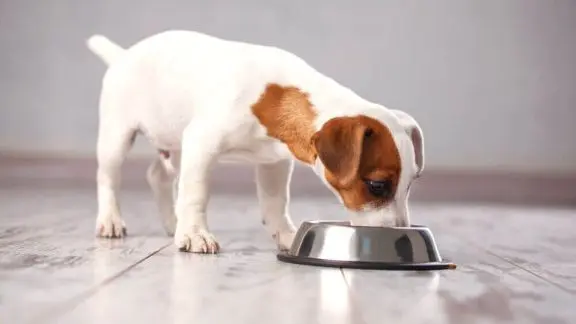
FEEDING BASICS
Puppies should receive a balanced diet of excellent quality, since it is up to a year that the foundation is laid for their health for life. The owner of the dog is obliged to provide food that is appropriate for the size of the dog and its breed. You can’t go to extremes, believing that the dog can eat everything and feed it with leftovers from the table. But it is also impossible to humanize a pet, deciding that the pet will receive only the most delicious, and give him delicacies that are intended for people – they will cause only one harm to the dog.
Improper nutrition can lead to obesity, cause internal diseases or skin diseases. Only nutrition that maintains the health of the animal will be correct. Therefore, it is very important to balance the dog’s diet in terms of the content of the main food components: proteins, fats, carbohydrates.
The easiest way to do this is to use ready-made puppy food , where the content of all these elements, as well as vitamins and minerals, is taken into account, calculated and balanced.
WHAT ARE THE MAIN INGREDIENTS IN DOG FOOD?
Meat should form the basis of the dog’s nutrition – be part of the feed or be the basis of natural nutrition. Meat is the main source of protein . But if the dog eats exclusively tenderloin, or, conversely, only defective parts (veins, skin and cartilage), this will lead to indigestion, so the meat base must be mixed from both pure meat and offal. This includes animal fat, which serves as a source of energy. Protein is also found in fish, seafood, dairy products and eggs.
To maintain healthy teeth and bones, skin and coat, the dog needs unsaturated fatty acids contained in vegetable oils. They are found both in plant products (sunflower, peanut, olive, soybean oil, sprouted wheat grains), and in animal products – in oily fish (salmon), in eggs. An excellent source of unsaturated fatty acids is fish oil.
Carbohydrates are energy providers for the body. They are found, for example, in cereals and are often added to ready-made feeds so that the dog eats up and has enough strength for active games and walks.
A complete food should also contain vitamins and minerals necessary not only for building the skeleton, but also for other metabolic processes. The body of a growing dog undergoes continuous restructuring. As a “building material” for bones and muscles, a puppy needs protein and carbohydrates, and vitamins and minerals as energy suppliers for metabolic processes. The total feed should consist of about a third of protein, at least 5% of fat and at least half of carbohydrates.

Thus, if you decide to feed your puppy with natural foods, you will need to take into account all of the above about food components in order to create a complete diet for him. In addition, it will be necessary to constantly adjust it, since the needs of the body will change with age. For example, as strange as it may seem, puppies and young dogs require more food than adult dogs of the same weight; up to five months – twice as much, and then – by about 50%. Their food should be two-thirds, and later at least half, consist of meat and other protein substances. It is easiest to follow the correct serving size by reading the information on the package of ready-made food that is appropriate for the age and needs of the dog.
By choosing ready-made puppy food, you will provide the puppy with all the necessary nutrients, you can change the food according to the age of the growing pet, offer him different tastes. In order to give out the required daily allowance, you will need to read the recommendations on the package.
HOW TO PROPERLY FEED A PUPPY AGED 1 TO 5 MONTHS
It is impossible to create an ideal diet for all puppies at once. Here you will need to take into account factors such as the breed, age, size and activity level of the puppy. Feeding a puppy taken from a breeder should continue for the first time according to the recommendations of the latter.
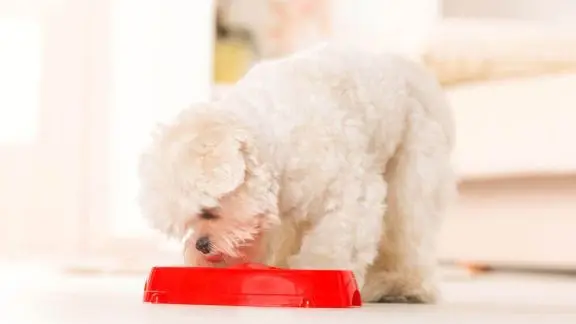
In the third or fourth week of life, puppies, in addition to mother’s milk, begin to receive the first complementary foods. Accordingly, it is the breeder who decides what kind of food the puppies will eat in the first months – either natural food or industrial food designed for very young puppies up to 1-2 months old. So when you pick up a puppy, which can be between one and a half and five months old, his digestive system will be adapted to exactly the food he received in his first months of life. For at least one week, you will need to keep your feeding schedule and diet unchanged to avoid digestive upsets caused by restructuring and the stress of moving to a new place. It will be easier for the puppy to get used to the new conditions, and then the change of home will be painless for him.
In the future, if for some reason you want to change the diet of a young pet, you can do this at any time. In this case, the best option would be to consult a breeder or veterinarian who will give you valuable recommendations.
Puppies should not be given the daily allowance of food at a time, they have too small a stomach that cannot properly digest the entire amount of food; the consequence of this will be an overload of the stomach. In addition, the ligaments, joints and bones will receive too much stress, which will only bring harm. In a healthy, well-fed puppy, the ribs do not protrude visually, but should be felt with the palm of your hand.
Underfeeding a puppy in the first months and up to a year will have negative consequences that are very difficult to correct. That is why it is so important to feed your puppy in a balanced way and to follow the exact feeding time. Following these two rules will help you keep his weight normal.
After eating, the puppy should be allowed to rest, as is customary with wild animals after a hearty meal. Otherwise, when playing immediately after eating, a life-threatening situation of twisting of a full stomach, which occurs in dogs of large breeds, may occur.
Number of feedings for puppies of different ages:
1st month – 5-6 times a day;
2-4th months – 4 times a day;
5th month – 3 times a day.
Divide the day from morning to evening into equal intervals and try to feed the puppy at this designated time.
What not to give to puppies:
- Rich meat broths.
- Chicken bones (tubular).
- Boiled bones.
- Smoked, salty, fatty.
- Sweets, chocolate in any form, cakes.
- Legumes.
- cabbage.
All of these products are either poisonous to dogs , or can damage the digestive tract, disrupt metabolism, and cause increased gas formation.
Only the general nutrition scheme is described here, for more detailed recommendations you can always contact the breeder or veterinarian. In the future, having studied the needs of the puppy, you yourself will be able to select the appropriate food and treats for him in order to raise a healthy dog out of him.
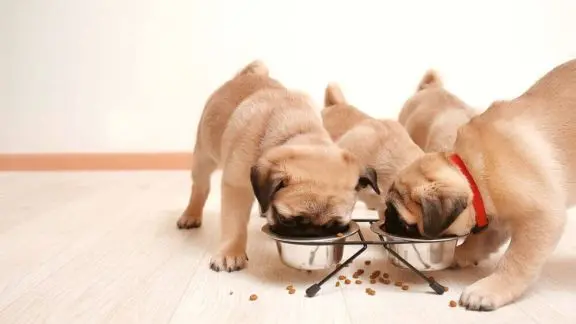
INDUSTRIAL PUPPY FOOD
According to the content of protein and other necessary substances, the finished feeds fully comply with scientifically based standards. The modern way of canning preserves vitamins better than home cooking. In the manufacture of destroyed pathogens contained in the meat. Another advantage is that you can always have a supply of food in the house. For example, when traveling, ready-made food is the easiest solution to a feeding problem. Dry food contains five times less water than normal wet food, so make sure you have water in a separate bowl. 200g of dry food has approximately the same nutritional value as 850g of whole food in a can, or 400g of meat and 125g of porridge. In this case, no additional goodies are needed – they lead to obesity!
Proper feeding of a puppy is the basis for the formation of a healthy animal. He needs more high-calorie food with a high protein content. During this period, the puppy’s digestive tract is not yet fully formed, and as the transition from mother’s milk to ready-made feeds, the bacterial flora of the intestine accumulates.
When choosing a diet for a puppy, it is important to take into account its age, size or breed , level of physical activity and individual health status. All these parameters are taken into account in PRO PLAN ® super premium dry food .
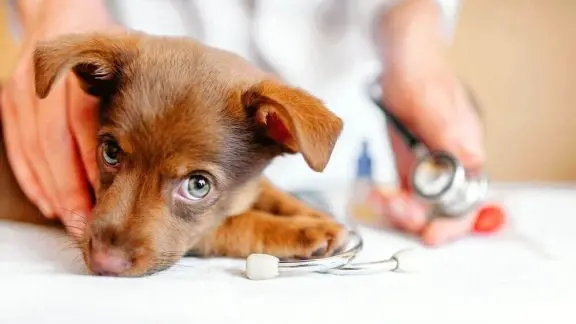
Water
Water, always fresh and clean, in no case icy, should be constantly freely available to the puppy. Although a healthy dog will hardly drink on food with normal moisture, he should be able to quench his thirst in the heat, after some effort, or with a certain food. Persistent increased thirst for no recognizable cause is a sign of illness.
POSSIBLE DISEASES OF PUPPIES
Puppies, like all children, can get sick with something. Diseases can be infectious and non-infectious, traumatic in origin and genetically transmitted. If you can encounter the latter unexpectedly, since some diseases that are inherited may appear at a later age, then other types of diseases can be avoided. To do this, you will need to strictly follow the recommendations for caring for a puppy, feed him properly and monitor his health.
INFECTIOUS DISEASES
Parvovirus enteritis is a dangerous infectious disease, one of the symptoms of which is intestinal upset. The lethality of this disease in puppies reaches 90%. You can avoid it by making the puppy the necessary vaccination on time.
Canine distemper is a viral infection that is very dangerous for puppies, almost always leading to death. It can manifest itself in various forms, the most dangerous is the nervous form. Vaccination is made against the plague of carnivores.
Adenovirus and canine viral hepatitis are infectious diseases caused by adenoviruses of the first and second types. Transmitted by airborne droplets or saliva from a sick dog. Most dangerous for puppies and young dogs. A timely vaccination against these diseases will protect the young pet.
Leptospirosis is an acute infectious disease that is contagious to humans, can be fatal to a puppy. The carriers of the disease are rats. Vaccination minimizes the risk of contracting the disease.
Rabies is a deadly viral infection that is contagious to humans and fatal to dogs and humans. Rabies vaccination is mandatory and annual.
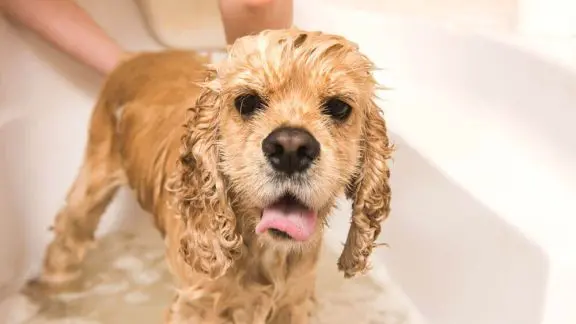
PARASITES
internal parasites
From all types of internal parasites that a puppy can infect (for example, round and tapeworms, worms, heartworms and others), special antihelminthic drugs have been developed that must be given to the puppy periodically.
External parasites
Fleas, lice, ticks that a puppy can infect while walking or communicating with relatives will not only cause him discomfort, but can also become a source of more serious diseases, causing otitis media, various dermatological diseases. Therefore, it is mandatory to periodically treat the puppy from external parasites. You can check the processing schedule with the breeder or veterinarian.
Other diseases
The puppy can also get sick for various other reasons, such as hypothermia, causing him to develop cystitis . Or, if you take a puppy in a car with open windows, where he will look out, then he may develop conjunctivitis . If the puppy lags behind in growth and development , or lameness begins , the problem may be related to malnutrition.
Of course, it is impossible to protect a puppy from all diseases one hundred percent. Therefore, you, as a responsible owner, should always carefully monitor any changes in the behavior and mood of the puppy, and at the first sign of illness, seek help from a veterinarian.
If you follow the correct feeding regimen, vaccinate and deworm on time, give feasible physical activity in accordance with the age of the puppy, then you can avoid most diseases, giving your pet a happy childhood.

